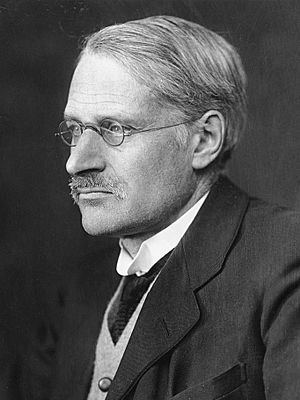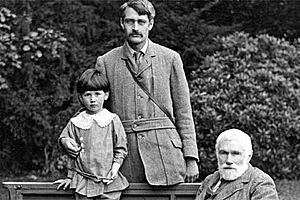G. M. Trevelyan facts for kids
Quick facts for kids
G. M. Trevelyan
|
|
|---|---|

Trevelyan photographed by George Charles Beresford in 1926
|
|
| 6th Chancellor of Durham University | |
| In office 1950–1957 |
|
| Preceded by | The Marquess of Londonderry |
| Succeeded by | The Earl of Scarbrough |
| Master of Trinity College, Cambridge | |
| In office 1940–1951 |
|
| Preceded by | Sir J. J. Thomson |
| Succeeded by | Edgar Adrian, 1st Baron Adrian |
| Regius Professor of History University of Cambridge |
|
| In office 1927–1943 |
|
| Preceded by | J. B. Bury |
| Succeeded by | Sir George Clark |
| Personal details | |
| Born |
George Macaulay Trevelyan
16 February 1876 Stratford-upon-Avon, Warwickshire, England |
| Died | 21 July 1962 (aged 86) Cambridge, Cambridgeshire, England |
| Resting place | Holy Trinity Church, Langdale, Cumbria |
| Spouse |
Janet Trevelyan
(m. 1904) |
| Occupation | Historian |
George Macaulay Trevelyan (born February 16, 1876 – died July 21, 1962) was a famous British historian and academic. He was known for writing many books about history. He was a Fellow at Trinity College, Cambridge, from 1898 to 1903.
After that, he spent over twenty years as a full-time writer. Later, he returned to the University of Cambridge. He became the Regius Professor of History there from 1927 to 1943. This is a very important teaching role. He also led Trinity College as its Master from 1940 to 1951. After retiring, he became the Chancellor of Durham University.
Trevelyan was the third son of Sir George Otto Trevelyan, 2nd Baronet. He was also the great-nephew of a famous writer, Thomas Babington Macaulay. George Macaulay Trevelyan believed in the ideas of the Whig political group. Whigs believed that ordinary people had a big impact on history. They thought that democratic government would lead to steady progress in society.
Trevelyan's history books were often very passionate. He once said that he wrote his books about Giuseppe Garibaldi because he felt a strong connection to the Italian patriots.
Contents
Early Life and Family
George Macaulay Trevelyan was born in 1876. His birthplace was Welcombe House in Stratford-upon-Avon, England. This was a large estate owned by his mother's family. His grandfather was a wealthy merchant and a Member of Parliament.
His father, Sir George Trevelyan, 2nd Baronet, was also an important person. He worked for the government as Secretary for Scotland. The family's main home was Wallington Hall in Northumberland.
George followed in his father's footsteps for his education. He went to Harrow School and then Trinity College, Cambridge. At Cambridge, he joined a secret society called the Cambridge Apostles. He also started a fun game called Lake Hunt, which was a human version of "hare and hounds."
In 1898, he earned a special fellowship at Trinity College. His first book, England in the Age of Wycliffe, came from his research. A professor named Lord Acton greatly inspired him. Lord Acton taught him about moral judgment and individual freedom.
Writing About Heroes
Trevelyan became famous for his books about Giuseppe Garibaldi. Garibaldi was an Italian hero who fought for freedom. Trevelyan showed Garibaldi as a brave leader who helped create the Italian nation.
His books about Garibaldi were published between 1907 and 1911. They were very popular and made Trevelyan a top historian. He described Garibaldi as a champion of freedom and progress. He also wrote about the beautiful landscapes where Garibaldi fought. Trevelyan even walked the same paths Garibaldi took!
These books helped people understand the fight for Italian independence. They also showed Trevelyan's strong belief in freedom and progress.
A Life of Learning and Teaching
Trevelyan taught at Cambridge until 1903. Then, he decided to become a full-time writer. He wrote many important history books during this time.
In 1927, he returned to Cambridge University. He became the Regius Professor of Modern History. This was a very important teaching job. He helped guide students who were studying history.
In 1940, he became the Master of Trinity College. This meant he was the head of the college. He held this position until he retired in 1951.
After retiring, he became the Chancellor of Durham University from 1950 to 1958. Trevelyan College at Durham University is named after him. He also received many awards and honors for his work. He won the 1920 James Tait Black Memorial Prize for his book Lord Grey of the Reform Bill. He was also made a fellow of the British Academy and the Royal Society.
Helping Others and Preserving History
During World War I, Trevelyan helped as an ambulance driver. He worked on the Italian front lines. His eyesight was not good enough for military service, so he helped in this way.
Trevelyan was also the first president of the Youth Hostels Association (YHA). The YHA helps young people explore the countryside. Their main office, Trevelyan House, is named in his honor.
He also worked hard for the National Trust. This organization helps protect historic places and beautiful landscapes in Britain. Trevelyan believed it was important to save these places for future generations.
Trevelyan's Books
G.M. Trevelyan wrote many books. Here are some of his most well-known works:
- England in the Age of Wycliffe (1899). This was his first book.
- England Under the Stuarts (1904). This book covers the years 1603 to 1714.
- Garibaldi and the Thousand (1909).
- Garibaldi and the Making of Italy (1911).
- The Life of John Bright (1913).
- History of England (1926). This book was updated in 1945.
- England Under Queen Anne (3 volumes) (1930–1934). This was a very detailed work.
- The English Revolution, 1688–1698 (1938). This book describes James II and the Glorious Revolution.
- A Shortened History of England (1942).
- English Social History: A Survey of Six Centuries: Chaucer to Queen Victoria (1942/1944). This book became his best-seller. It looked at how everyday life changed in England over many centuries.


